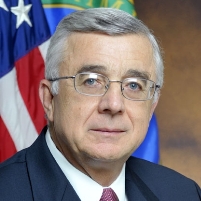President Obama’s selection to serve in the Department of Energy as Assistant Secretary for Fossil Energy, Dr. James J. Markowsky, is an energy industry veteran with a strong technical background in research and development. While exciting and novel energy technologies like solar and wind get all the press, the U.S. (and the world) will continue to rely primarily on fossil fuels for decades to come. Thus, any strategies to meet the global climate crisis will have to include a fossil fuel component. Nominated May 28, 2009, and confirmed August 7, Markowsky serves as the primary policy advisor on issues involving coal, oil, and natural gas, including research and development efforts in those areas. The Office of Fossil Energy oversees approximately 600 research and development projects, ranging from development of zero-emissions power plants to energy facilities that transform coal, biomass and other fuels into commercial products to new technologies that can extract oil from existing fields that currently are unreachable. The office is also responsible for managing the country’s underground supply of oil for use in case of emergencies, known as the Strategic Petroleum Reserve, and running three research labs that conduct fossil energy exploration.
Born circa 1945 in occupied
Germany to
Ukrainian refugees who in 1948 emigrated to the U.S., Markowsky earned a B.S. in Mechanical Engineering from Pratt Institute in 1967, an M.S. and Ph.D. in Mechanical Engineering from Cornell University in 1970 and 1971, respectively, and an M.S. in Industrial Management from the Massachusetts Institute of Technology in 1981.
Shortly after earning his doctorate, Markowsky went to work at
American Electric Power Service Corporation (AEP), where he remained through 2000. AEP is a large investor-owned electric utility, which is among the nation’s largest generators of electricity and owns the nation’s largest electricity transmission system. Markowsky began his thirty-year career at AEP in 1971 as a Senior Engineer in AEP’s Mechanical Division. In 1977, he was named Program Manager for AEP’s pressurized fluidized bed combustion development program. He was named head of the Mechanical Engineering Division and elected Assistant Vice President in 1984; Vice President for Mechanical Engineering in 1987; Senior Vice President and Chief Engineer in 1988; Executive Vice President for Engineering and Construction in 1993; and Executive Vice President for Power Generation in 1996, a post he held at his retirement in 2000.
After his retirement from AEP, Markowsky was President of
Research and Development Solutions, LLC, from 2004 to 2005, which had a
$41 million contract to provide Research and Development Support Services to the DOE’s
National Energy Technology Laboratory. He is or has been a member of the
National Research Council Committee on America’s Energy Future, Chair of the
National Academy of Engineering Section 6 - Electric Power/Energy Systems Committee, the
Association of Edison Illuminating Companies Power Generation Committee, the
American Society of Mechanical Engineers Industry Advisory Board, Chairman of the
Coal Utilization Research Council, the
Electric Power Research Institute Research Advisory Committee, and Chairman of the EPRI Fossil Power Plants Business Unit Council Steering Committee. He has 26 publications to his name in the area of power generation and fossil energy, and he served as an Adjunct Associate Professor at City College of New York from 1975 to 1977.
Markowsky and his wife, Carolyn, reside in Columbus, Ohio, and have a daughter, Lynn Berry. Markowsky contributed to candidates from both parties in the 1990s, although mainly to Republicans. He contributed $500 to the congressional campaign of Republican Ralph Regula in 1994, $250 each to Republicans George Voinovich (Senate) and Bob Ney (House of Representatives) in 1995, and $250 to Democrat Ted Strickland, who was running for re-election to Congress in 1998.
- Matt Bewig







Comments